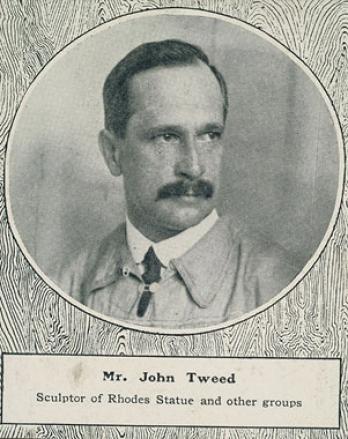
| John Tweed 1869 - 1933 Sculptor. After studying at Glasgow School of Art, Tweed moved to London aged twenty-one. There he attended the RA Schools and worked as an assistant to Hamo Thornycroft. In 1893 he travelled to Paris, where he met and befriended Rodin, and worked under Alexandre Falguière. Following his return to England , in collaboration with the architect, Herbert Baker, to whom he had been recommended by Edwin Lutyens, Tweed executed a relief of The Landing in Table Bay of van Riebeck, 1st Governor of the Dutch Colony, for the Cape Town residence of Cecil Rhodes (1893). Rhodes commissioned Tweed to produce massive reliefs for the site of his own tomb in the Matoppos in Rhodesia, but the two fell out. Later Tweed was commisioned for a statue of Cecil Rhodes in Bulawayo (1902). Tweed’s French training is very much in evidence in the vigorous action of his figure of Colonel G.E. Benson (1902-4), for Hexham, Northumberland, but some members of the art establishment were wary of the inclusion in public monuments of the sort of poetic allegory which Tweed had learned from Rodin, and of his occasionally impressionistic style. Nevertheless, both before and immediately after World War I, Tweed was a great favourite of the Office of Works and of the military. In 1912, he completed the long-awaited equestrian statue of the Duke of Wellington, following the design of Alfred Stevens, for the summit of Stevens’s tomb of the duke in St Paul’s.. This brought him further large-scale commissions. Tweed’s major works in London are Lord Clive (1917), Sir George White (1922), Lord Kitchener (1926), the Rifle Brigade Memorial (1925), the House of Lords War Memorial (1932). Tweed also executed church monuments, such as the polychrome alabaster Memorial to Bishop Wilbeforce (1909) in Chichester Cathedral, and the Memorial to Lord Roberts in St Paul’s. Some of his ideal works are housed in the Reading Museum and Art Gallery, which also holds a large collection of his papers. Since Tweed remained Rodin’s most active supporter in the British art world, these papers are a major source of information on Rodin as well as on Tweed. |